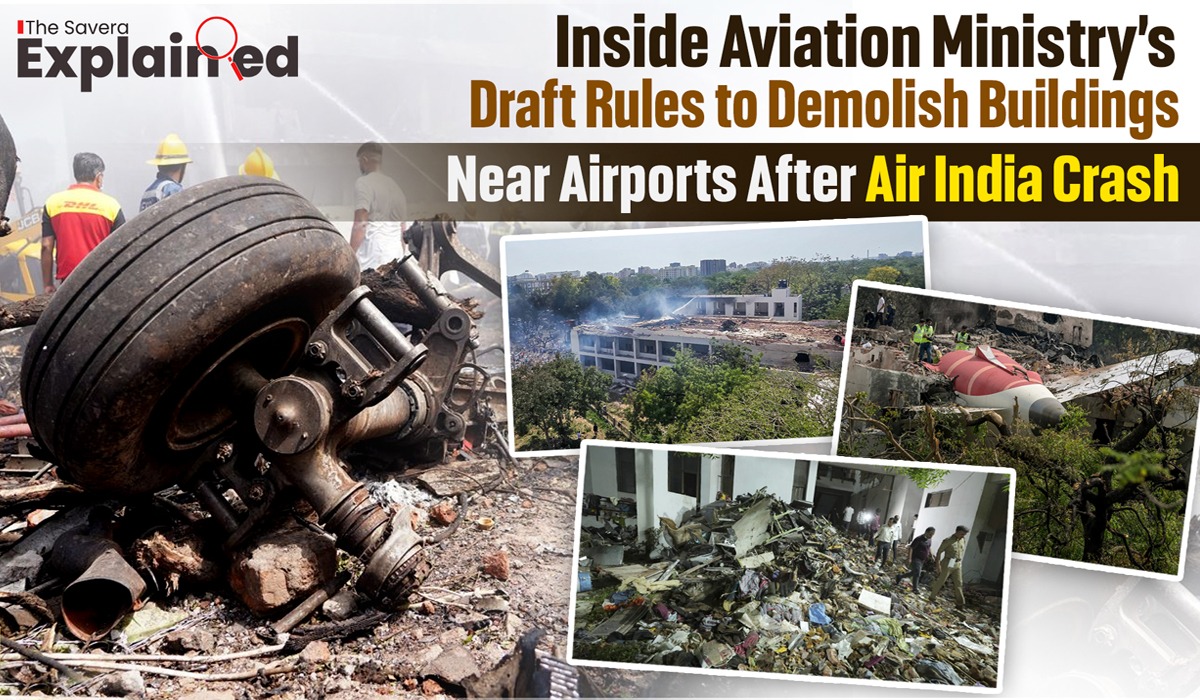In the wake of the recent Air India crash, the Civil Aviation Ministry has implemented the latest rules as part of the precautionary measures being taken to enhance flight safety. This tragic incident has prompted the government to act swiftly to prevent such disasters in the future.
On June 12, 2025, Air India Flight AI171, a Boeing 787-8 Dreamliner, crashed shortly after taking off from Ahmedabad’s Sardar Vallabhbhai Patel International Airport. The flight was headed to London Gatwick and carried 242 passengers and crew members. Just moments after take-off, the plane issued a “mayday” emergency call, reached a height of about 650 feet, and then rapidly descended, crashing into a medical college hostel in the Meghani Nagar area, a crowded residential neighbourhood.
The crash claimed lives of around 241 people on board, with only one passenger, Vishwaskumar Ramesh, surviving. Additionally, at least 29 people on the ground, including medical students, lost their lives, bringing the total death toll to at least 270. This disaster is one of the worst aviation tragedies in India’s history and the deadliest in the world in over a decade. The sole survivor, a British national of Indian origin, walked out of the wreckage with non-life-threatening injuries, calling his survival a “miracle.”
Government’s Response: Increased Awareness and Stringency
The Air India crash sent shockwaves across India and the world, raising serious concerns about aviation safety. The government, led by Civil Aviation Minister Ram Mohan Naidu, recognized the urgency of addressing potential risks in air travel. Prime Minister Narendra Modi visited the crash site and met with survivors, emphasizing the need for a thorough investigation and improved safety measures.
The tragedy highlighted issues like obstructions near airports and the need for rigorous maintenance checks. As a result, the government has become more vigilant, adopting a stricter approach to ensure such incidents don’t happen again. The Ministry of Civil Aviation, along with the Directorate General of Civil Aviation (DGCA) and the Aircraft Accident Investigation Bureau (AAIB), is working to identify the crash’s cause and prevent future risks.
Steps Taken by the Civil Aviation Ministry
To address these concerns, the Civil Aviation Ministry has introduced several proactive measures:
New Draft Rules for Obstructions Near Airports:
- Released Aircraft (Demolition of Obstructions caused by Buildings and Trees etc.) Rules, 2025 on June 18, 2025.
- Aims to remove structures, buildings, or trees near airports that endanger aircraft during take-off/landing.
- Authorities can issue notices to property owners for height violations and demolish/trim obstructions.
- Public feedback opens for 20 days; rules effective upon publication in Official Gazette.
Enhanced Safety Inspections for Boeing 787 Fleet:
- DGCA ordered Air India to inspect 33 Boeing 787-8 and 787-9 aircraft with GE Aerospace GEnx engines.
- Includes one-time checks of take-off parameters, electronic engine control tests, and daily fuel-related checks starting June 15, 2025.
- Ensures technical issues are detected; no major concerns found yet, but inspections continue to prevent delays/risks.
Investigation and Transparency:
- AAIB leads crash probe with U.S. and U.K. expert support.
- Both black boxes (flight data recorder, cockpit voice recorder) recovered for analysis.
- Possible causes: engine failure, flap issues, or other factors.
- High-level committee formed to review crash and suggest long-term safety measures.
Training and Compliance Checks:
- DGCA requested training records for Flight AI171 pilots and dispatcher to verify compliance.
- All Indian flying schools asked to review training, maintenance, and licensing procedures.
- Focus on strengthening emergency preparedness.
However, these rules, particularly the provision to demolish buildings or trim trees, are likely to have significant impacts on people living or working in affected areas. Below is an analysis of the potential impacts, presented in simple terms and structured as pointers for clarity.
Potential Impacts of the New Draft Rules on People
- Displacement and Loss of Homes:
- Residents in densely populated areas near airports, like those around Ahmedabad’s Sardar Vallabhbhai Patel International Airport, may face eviction if their homes violate height restrictions.
- Demolition orders could force families to relocate, disrupting their lives and potentially leaving them without immediate housing alternatives.
- Economic Hardship for Property Owners:
- Property owners, including homeowners and small business operators, could lose valuable assets if buildings are demolished without fair compensation.
- Rebuilding or relocating businesses (e.g., shops, clinics, or hostels) may be financially crippling, especially for low-income or middle-class owners.
- Impact on Livelihoods:
- Workers employed in buildings targeted for demolition, such as medical staff or students in hostels like the one hit in the Air India crash, could lose their workplaces or accommodations.
- Construction workers or vendors reliant on airport proximity may face reduced income if structures are removed.
- Legal and Administrative Challenges:
- Residents may file lawsuits to contest demolition orders, leading to delays in implementing the rules and straining local courts.
- The short feedback window (20 days) could spark criticism for limiting public input, especially for those unaware of the draft rules.
- Environmental Concerns:
- Trimming or removing trees to comply with the rules could reduce green cover near airports, affecting local ecosystems and air quality.
- Demolished buildings may leave vacant lots or debris, altering the aesthetic and functional landscape of neighbourhoods.

